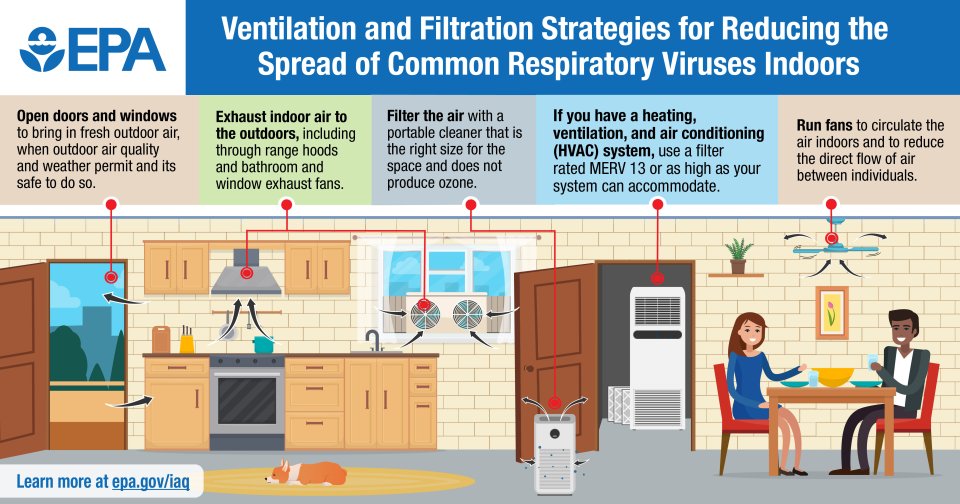Ventilation and Respiratory Viruses
Información disponible en español
Learn how to improve ventilation in homes, schools, and other buildings to prevent the spread of common respiratory viruses indoors.
On this page:
- Ventilation and Respiratory Virus Prevention
- Ventilation in Homes
- Ventilation in Schools, Offices, and Commercial Buildings
On other pages:
- Indoor Air and Coronavirus (COVID-19)
- Preventing the Spread of Respiratory Viruses in Public Indoor Spaces
- Indoor Air in Homes and Coronavirus (COVID-19)
Ventilation and Respiratory Virus Prevention
Each year, respiratory viruses are responsible for millions of illnesses and thousands of hospitalizations and deaths in the United States. In addition to the virus that causes COVID-19, there are many other types of airborne respiratory viruses, including influenza (flu) and respiratory syncytial virus (RSV), that can spread more easily indoors than outdoors since their concentration can build up indoors and people are often closer to each other.
One important approach to reduce the spread of common respiratory viruses, is to increase ventilation, which is the amount of air moving in and out of a building. Ventilation removes indoor air that may be concentrated with airborne viruses and replaces it with fresh outdoor air.
Ensuring proper ventilation is an important component of promoting good indoor air quality in general. Ventilation provides improved indoor air quality and health benefits by reducing the levels of other indoor pollutants, such as particulate matter (PM), volatile organic compounds (VOCs) and biological pollutants (including respiratory viruses).
Key Times for Prevention
Improving ventilation and implementing other preventive actions are especially helpful when:
- Respiratory viruses are causing a lot of illness in your community.
- You or the people around you were recently exposed to a respiratory virus, are sick, or are recovering.
- You or the people around you have risk factors for severe illness.
Ventilation in Homes
There are many ways to bring outdoor air into your home to keep virus particles from accumulating, including:
- Opening windows and doors when it’s safe to do so;
- Operating exhaust, window or attic fans; and
- Running a window air conditioner with the vent control open.
Each of these ventilation approaches will help clear out virus particles in your home. Using multiple approaches simultaneously may be even more effective.
You may also consider using bathroom and kitchen fans and rangehoods that exhaust air outdoors to help move air and indoor contaminants to the outdoors. Running fans will also encourage more outdoor air to come indoors, which can further dilute virus particles in the air.
Run fans to circulate the air indoors and to reduce the direct flow of exhaled air from one individual to another.
To further limit virus particles from accumulating in indoor air, consider using a portable air cleaner and/or upgrading the filter in your heating, ventilation, and air conditioning (HVAC) system. Select a furnace filter that is rated MERV 13 or as high as your system will accommodate. Operate HVAC systems with furnace filters continually by placing the fan setting in the “On” position. When these strategies are used in conjunction with increased ventilation, you can clear out virus particles in your home more effectively. These approaches for filtering the air may also be helpful in situations when only a limited amount of ventilation with outdoor air is possible, such as when opening doors and windows would create a safety risk and during gatherings or when you have visitors. Learn more about Air Cleaners, HVAC Filters, and Coronavirus (COVID-19).
Learn More About Ventilation in Homes
- Indoor Air in Homes and Coronavirus (COVID-19)
- Centers for Disease Control and Prevention:
Ventilation in Schools, Offices, and Commercial Buildings
Most schools, offices, and commercial buildings have HVAC systems that bring in outdoor air and can filter some of the particles out of the air. Typically, these systems are maintained by building or HVAC professionals. Professionals who operate school, office, and commercial buildings should consult guidance by ASHRAE (formerly known as American Society of Heating, Refrigerating and Air-Conditioning Engineers), and other professional and government organizations for information on ventilation and air filtration to help reduce the spread of respiratory viruses indoors. Increasing ventilation and filtration are usually effective strategies; however, due to the complexity and diversity of building types, sizes, construction styles, and the complexity of HVAC system components and other building features, a professional should interpret ASHRAE and other pertinent guidelines for their specific building and circumstances.
Increasing ventilation with all or mostly outdoor air may not always be possible or practical (e.g., during a wildfire or extreme weather). In such cases, using portable air cleaners or upgrading HVAC filters may help reduce the concentration of airborne virus particles indoors. The effective rate of ventilation per person can also be increased by limiting the number of people present in the building in general, or in specific rooms. Administrative practices that encourage remote participation and reduce room occupancy can also help reduce the spread of respiratory viruses.
Learn more about Preventing the Spread of Respiratory Viruses in Public Indoor Spaces.
Learn More About Ventilation in Schools, Offices, and Commercial Buildings

